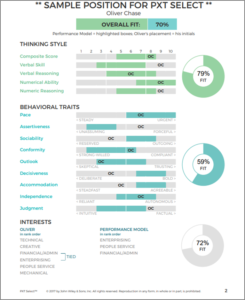 Can you relate to Robert? As a new manager, Robert was tasked with making hiring decisions all too often. It seemed that the company couldn’t retain employees. Robert had to make hiring decisions from a very shallow pool of candidates since the positions he needed to fill were specialized. To perform at an expected level, Robert needed employees who could do the job with little guidance since Robert frequently traveled. The position required extensive prep work that if managed poorly would lead to unfortunate time drains, as well as extensive cleanup.
Can you relate to Robert? As a new manager, Robert was tasked with making hiring decisions all too often. It seemed that the company couldn’t retain employees. Robert had to make hiring decisions from a very shallow pool of candidates since the positions he needed to fill were specialized. To perform at an expected level, Robert needed employees who could do the job with little guidance since Robert frequently traveled. The position required extensive prep work that if managed poorly would lead to unfortunate time drains, as well as extensive cleanup.
In interviewing potential candidates, Robert’s main source of a person’s character was word of mouth, if someone knew that candidate, and/or other supervisor’s opinions. Resumes were useful up to a point, but Robert never found much value in them when trying to determine if a candidate was a good fit.
Robert’s best-performing employee had no resume, spoke the language sparingly, and yet Robert received a constant stream of compliments about this employee, and he continued to grow and improve his skills and abilities. In Robert’s previous hiring decisions, some of the new hires did not get along with this employee, others wanted to be in charge, some were engaged for the first couple of weeks before checking out and becoming a payroll drag, and some were overqualified and were good employees for a short period before leaving.
What all of these former employees had in common was that they showed initial interest and wore just enough of a mask to make them look like great employees. They also had great resumes with plenty of references and previous experience. They seemed to be qualified. What none of them possessed was working in unique conditions and under the type of pressure that came with this job. The demands of the job were just too much for most people, even though they were well compensated. The challenge of finding the right person was a task that Robert came to despise.
Robert’s situation isn’t unique. Making the right hiring decisions are critical to a team’s future performance and a company’s success, but making the wrong decisions is costly in many ways. As a leader, relying on a candidate’s resume and references, while important, only enables insight into past performance and accomplishments in some other company. What is needed is a tool to help determine if a candidate is a good job fit. PXT Select is just such a tool. PXT Select increases the probability that a new hire is a good choice.
PXT Select measures cognitive and behavioral traits and interests to help find the ideal candidate, which reduces turnover and boosts engagement. Consider the following sample performance model. The area shaded green on each dimension depicts the range of scores for successful candidates for this position. It also depicts the candidate’s scores.

This candidate, Oliver Chase, fits the performance model in some areas while other areas are outside the performance model. For example, in Thinking Style, Oliver’s score is higher than successful candidates typically would score. A concern for Oliver is that he might not find the job as stimulating as he would like. In the Behavioral Traits, Oliver is three “stens” outside the score of most successful candidates in Assertiveness and Decisiveness. In the area of Assertiveness, Oliver may be more forceful in his approach than appropriate. If you were Oliver’s manager, you may have to spend time putting out fires that Oliver creates due to his assertive nature.
This performance model can be adjusted based on the unique needs of the position in a given company by completing a Job Analysis Survey that is incorporated into the performance model.
Additionally, PXT Select aids the interviewer by providing tailored questions to ask and what to listen for based on the candidate’s assessment results. While it would be nice if the ideal candidate would just skip through the door, using PXT Select will increase the likelihood that we will be the ones skipping through the doors because of the successful hiring decision that we made.
Switzer Associates Leadership Solutions has the expertise to help facilitate you incorporating PXT Select in your hiring process. Call 916-622-3545 for a no-cost consultation with Dr. Switzer and learn how to find candidates who are the best fit for your company.
For the Faith-Based
 In making hiring decisions Jesus was par excellence. His choosing of the twelve disciples out of all the very capable and talented men in Judea at the time must have struck many as odd. Jesus chose men with occupations as varied as fisherman and tax collector. In Matthew Chapter 4, Jesus chose Peter and Andrew as they were casting nets into the sea of Galilee, and James and John as they were mending their fishing nets. When they were chosen, all four left what they were doing and followed Jesus right away (v. 18-22), just as Matthew the tax collector did when Jesus said to him, “Follow me” (v. 9:9).
In making hiring decisions Jesus was par excellence. His choosing of the twelve disciples out of all the very capable and talented men in Judea at the time must have struck many as odd. Jesus chose men with occupations as varied as fisherman and tax collector. In Matthew Chapter 4, Jesus chose Peter and Andrew as they were casting nets into the sea of Galilee, and James and John as they were mending their fishing nets. When they were chosen, all four left what they were doing and followed Jesus right away (v. 18-22), just as Matthew the tax collector did when Jesus said to him, “Follow me” (v. 9:9).
These men lived and traveled with Jesus for three years. He mentored them. He coached them. Jesus entrusted his church to these men.
Testimony to Jesus’ selection is found in Acts 4:13, “Now when they saw the boldness of Peter and John, and perceived that they were uneducated, common men, they were astonished. And they recognized that they had been with Jesus.” (ESV) Eleven of them remained true to their calling, most giving their lives for the faith—and, of course, the church as we know it today was built on the foundation they laid.